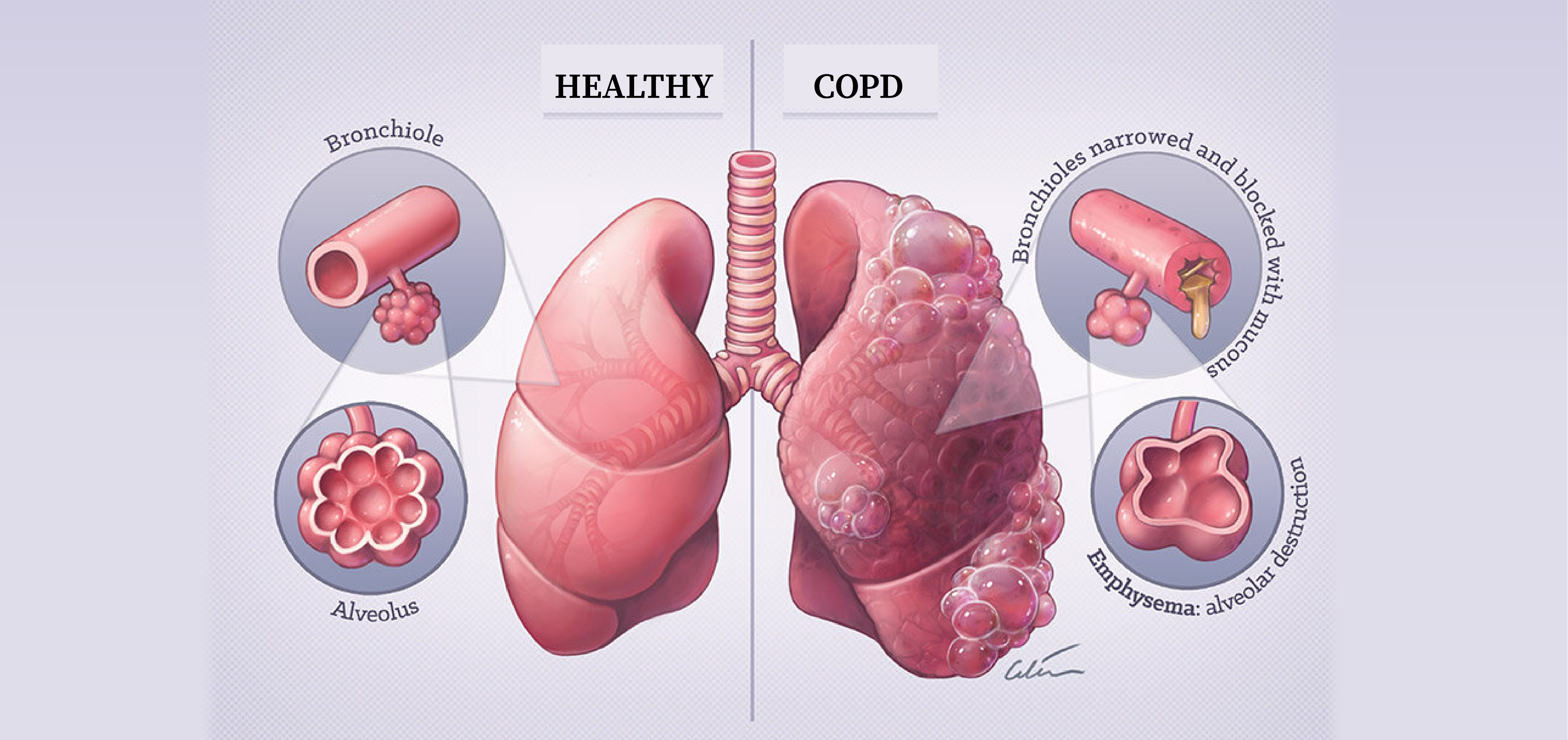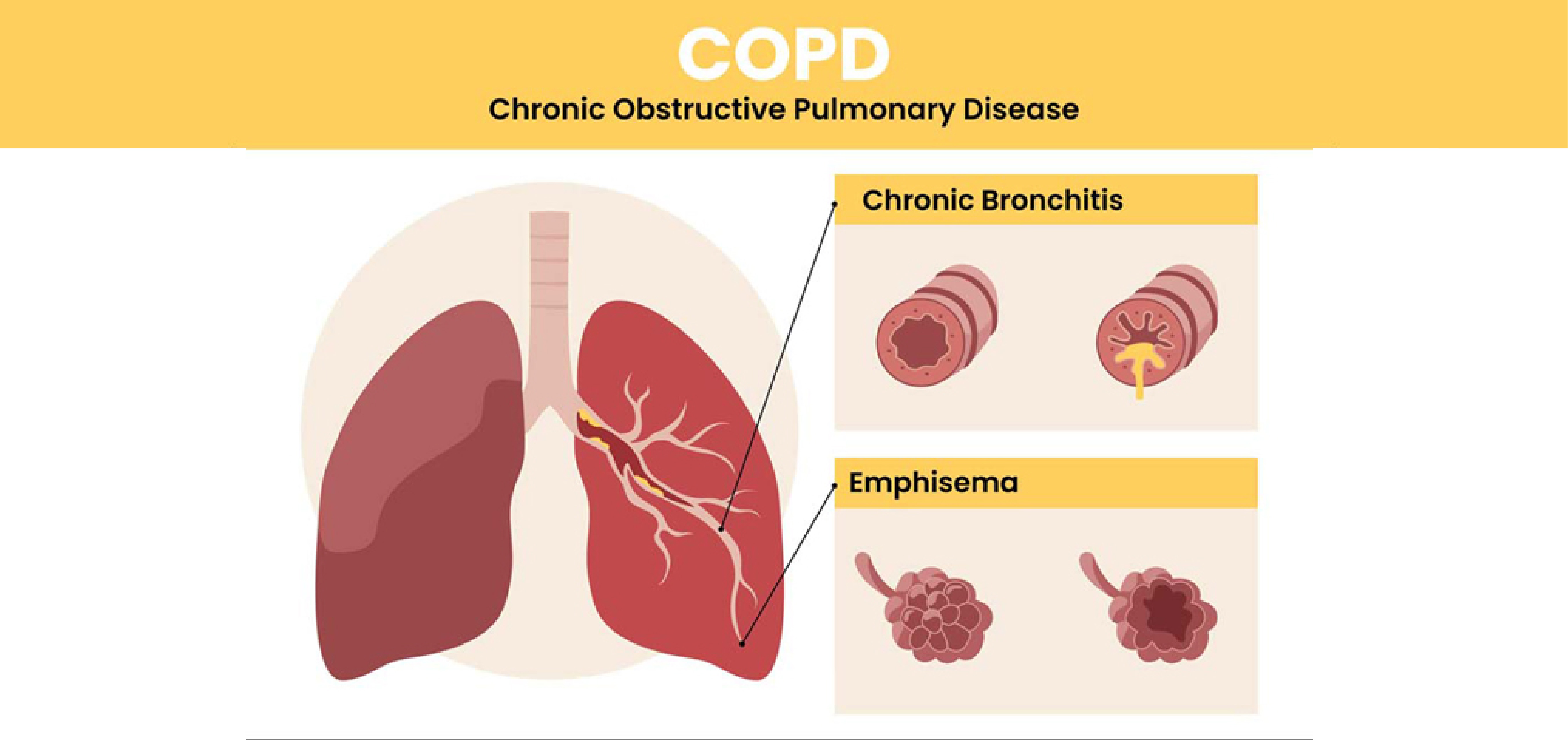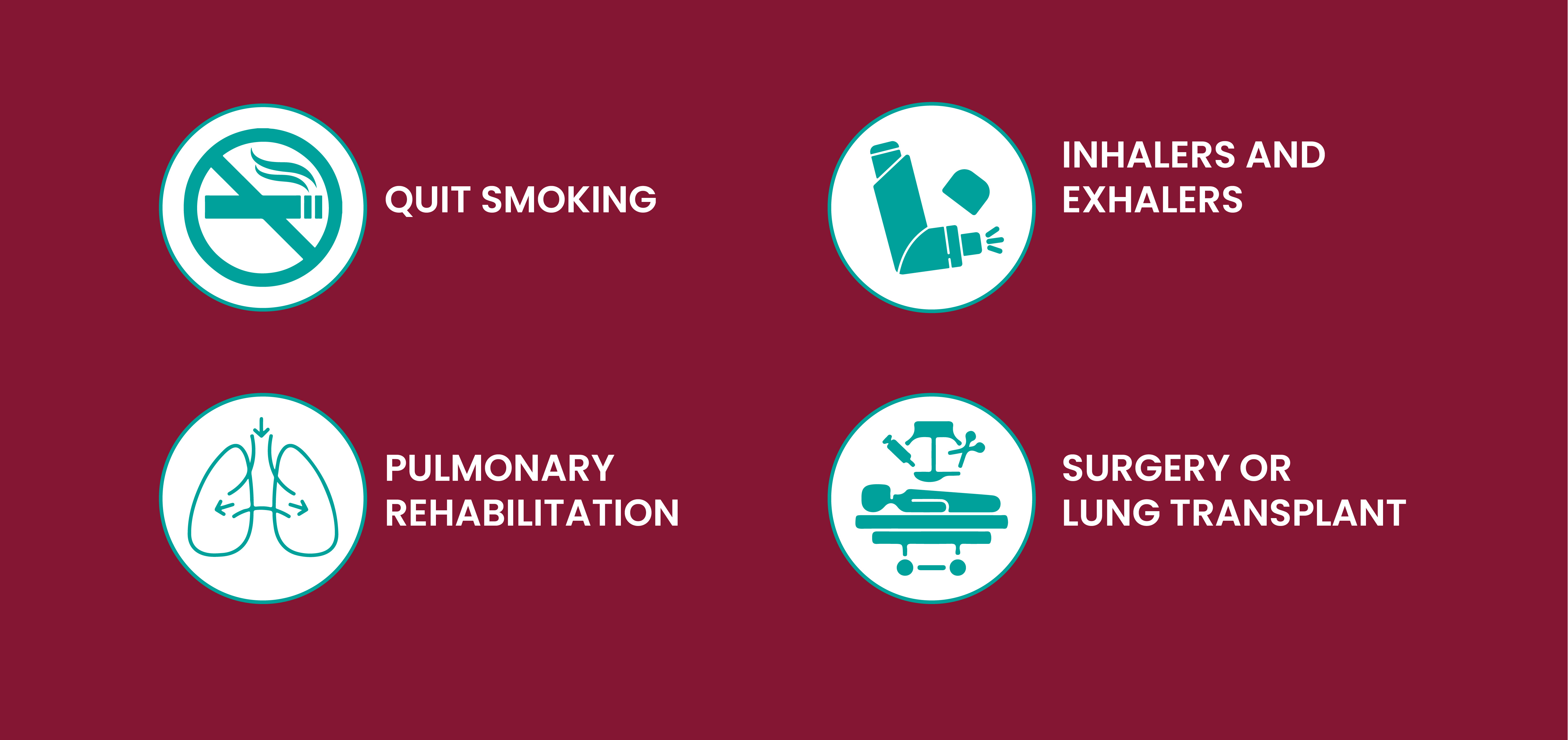What is COPD?

COPD often referred to as Chronic Obstructive Pulmonary Disease, covers a variety of conditions that compromise breathing and impede airways. Chronic Bronchitis and Emphysema are among them.
The diameter of the airways become smaller in COPD as compared to the healthy airways because of the inflammation in the airways. It also occurs due to excessive mucus production which gets accumulated in the airway passage. It is an irreversible condition, since the damage to the lungs cannot be undone.
The patients with COPD usually have both Emphysema and Chronic Bronchitis but the severity of the condition varies from individual to individual.

Emphysema: Damage to the linings of many of the lungs air sacs leads to the development of emphysema. The air sacs are normally elastic or stretchy. When you inhale, the air is filled up in each air sac, expanding it like a small balloon. When you exhale, the air sacs collapse and the air escapes. Emphysema makes it difficult to expel air from your body.
Chronic Bronchitis: The lining of the airways become repeatedly or continuously inflamed and irritated, which results in Chronic Bronchitis. Breathing becomes challenging as the airways fill with a lot of thick mucus.
There is no cure for COPD, but there are medications that help to relieve the symptoms and prolong the lifetime of a patient. The complications can be treated with the oxygen therapy, pulmonary rehabilitation, or other medications.
What are the symptoms of COPD?
It is observed that the symptoms of COPD start to appear, once enough damage has been occurred to the lungs. These symptoms often worsen over time, and can limit your ability to do routine activities if smoking exposure still persist.
Symptoms of COPD are
- Shortness of breath
- Persistent wheezing or coughing
- Recurrent respiratory infections
- Lower energy levels
- Unexplained weight loss
- Excessive mucus or phlegm production

Patients with COPD may experience certain episodes of exacerbation which is nothing but worsening of the symptoms of COPD. A decreased respiratory function is observed every time a person experiences exacerbation.
What causes COPD?
Almost 90% of the COPD cases are due to smoking tobacco. Other prevalent causes are:
- Passive Smoking
- Biofuel burning and Air Pollution
- Exposure to harmful chemicals, toxins and dust particles at work
- Genetic Disorder, Alpha -1 Antitrypsin Deficiency.
- Perennial exposure to cooking fumes without proper ventilation.
Who develops COPD?
More than 15 million people in the US are affected by COPD and many more are unaware of their condition. The majority of patients diagnosed are females. According to the Centers for Disease Control and Prevention (CDC), COPD is the fourth most common cause of death in the United States and a major cause of disability. The groups that are more likely to be affected by COPD are:
- Women
- People aged between 65 to 74 years and more than 75 years
- American Indians/Alaska Natives and multiracial non-Hispanics.
- Current or former smokers.
- People with a history of asthma.
- People who have experienced living in homes where cooking or heating fumes were constantly present.
- People who have spent many years working in filthy or smoke-filled environments
What are the complications or effects of COPD?
Individuals with COPD are more prone to:
- Activity restrictions, such as trouble walking or climbing stairs
- Be unable to work
- Require special equipment’s like portable oxygen tanks
- Not participate in social activities like going out to eat, visiting places of worship, attending gatherings or hanging out with friends or neighbors
- Show signs of confusion and memory loss
- Increased emergency room visits or overnight hospital stays
- Suffer from chronic diseases like arthritis, congestive heart failure, diabetes, coronary heart disease, stroke or asthma
- Suffer from depression or other mental or emotional conditions
- Describing fair or poor health status
What are the possible diagnostic methods for COPD?
- Arterial blood gas analysis: This blood test helps us to know how efficiently your blood is carrying oxygen and removing carbon dioxide.
- CT Scan: Detection of emphysema can be done with the help of a CT scan of your lungs. It will also help in the determination of benefits that a patient might get after a surgery and whether a surgery is possible for certain cases of COPD or not. It can also help to detect the presence of lung cancer.
- Chest X-Ray: With the help of X-Ray, identification of emphysema becomes quite easier. It might also rule out the possibilities of other lung diseases and heart failure
- Lung function test: These tests determine the inspiration as well as the expiration rate and whether enough amount of oxygen is being delivered to your blood. The most often used test is Spirometry which requires blowing air into a large tube that is attached to a machine that measures how much air you can hold in your lungs and how easily you can expel it.
What are the treatment options for COPD?
As there is no cure for COPD, there are certain medications and therapies available that can help inslowing the progression of the disease and may even control the symptoms.
The various treatment options include: -
- Quit Smoking : Smoking worsens COPD. After being diagnosed for COPD, you have to quit smoking immediately.
- Inhalers and Exhalers : It is used for easy breathing.
- Pulmonary rehabilitation : A specialized course for exercise and education.
- Surgery or Lung Transplant : This is an option for very rare number if cases, where other options seem to be very less effective.

Other treatment options that may be additionally required in case of worsening of the symptoms are:
- Long term oxygen therapy : If COPD causes persistent low levels of oxygen, then an additional therapy i.eLong term Oxygen Therapy may be required by the patient throughout the day especially for the minimum period of 16 hours a day.
- Nebulized Medicine : This is a choice of additional therapy when inhalers don’t work efficient, the medications can be administered in a nebulized form.
- Ambulatory oxygen therapy: It refers to the oxygen that is required when you walk or exercise
- Non-invasive ventilation : In case of exacerbation, when it is hard to control the symptoms at home and the patient is taken to the hospital,a non-invasive ventilation is provided to the patients to ease their breathing.
It is done with the help of a portable machine attached to mask that covers the nose and mouth and eventually help in easier breathing.
 Call For Appointment
Call For Appointment